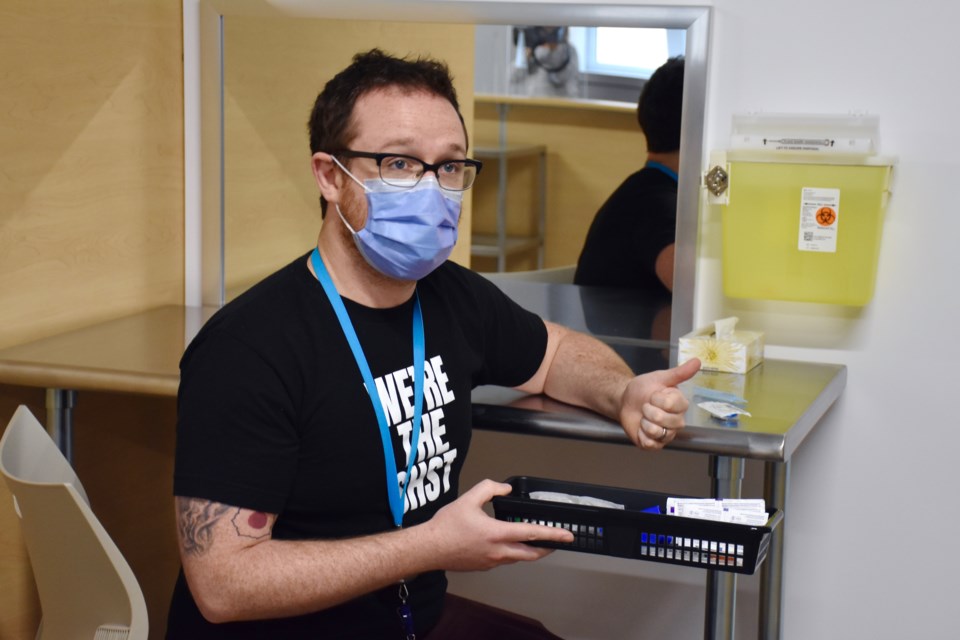Timmins first safe injection site is a place that could save lives, says Patrick Nowak.
Ahead of Safe Health Site Timmins (SHST) officially opening on Monday, July 4, the Timmins and District Hospital addictions program manager said it's a space where people will be taken care of.
"We hope to see things like decreased 911 calls for the community as they’ll be medically managed here. We hope to see things like less discarded needles downtown ... and sparing people from the grief that happens when a preventable death happens,” he said.
Today, a ribbon-cutting ceremony was held to introduce people to the new facility located at 21 Cedar St. N., across from city hall in the former Living Space location.
It's a service that's taken just under two years to come to fruition.
Timmins doctors Julie Samson and Louisa Marion-Bellemare first talked to council about the treatment of addictions in the city in October 2020. An overdose prevention site is part of their multi-pronged vision to tackle the issue. Health Canada approved the site in late June 2022.
Related: Safe injection site location chosen for number of reasons
See: $2.3M will add 15 new addictions treatment beds in Timmins
As a community, Marion-Bellemare said people should be proud the evidence-based site opened in such a short period of time.
"We know that people who come here will have access to harm reduction supplies and also education around harm reduction and that many people who come here do access treatment and do stop using drugs. Those are really, really important messages to remember. And that it does make our communities cleaner,” she said.
SHST is an urgent public health needs site (UPHNS) and is a temporary solution to bridge the gap while work continues to secure a permanent supervised consumption site.
“The opiate crisis unfortunately isn’t going away. We need to just continue to reduce stigma, work as a community and continue to provide improved access for clients who are in need, who need our services, who need our help in the community,” she said.
While the permanent site has a funding stream, the temporary operation does not. Last year, the City of Timmins committed over $1 million for the UPHNS. The hospital is operating the facility that employs nurses as well as harm reduction and community and safety liaison workers.
How it works
In total, the process from in-take to post-consumption care takes about 40 minutes. The Timmins site allows use by injection, oral drugs and snorting of substances. People cannot smoke in the facility.
Here's a look at how it works:
- A client rings the doorbell and is let into the reception area. As an anonymous service, they're are given a four-number code, which is similar to how people access harm reduction supplies at the Porcupine Health Unit or Living Space, said Nowak. Staff will determine why the person is at the site as it can be for naloxone (intransasal Narcan), needles or pipes, to be referred to services or to simply use the bathroom.
- If someone is there to use the safe injection services, they will be asked what drugs they're using, when was the last time they overdosed and other pertinent questions, said Nowak. This data also helps track if drug alerts need to be issued publicly. Personal belongings are left in a locker at the entrance. “All we would want … if possible, is them going in there with the substances. Recognizing that some people do carry weapons … some people have a variety of valuables on them and we don’t necessarily want them in there in the event an overdose happens,” he said.
- There's a room for people to pick the supplies needed, which Nowak said "is another way to give education about safer use practises." Even if people aren't using the site, they can access harm reduction supplies such as clean needle kits and nalaxone.
- In a sterile room under the supervision of a nurse, people can consume their drugs in one of three booths with safe and clean supplies. If an overdose occurs, Nowak said staff is "well prepared" to take care of it.
- After using, people are encouraged to stay in a post-consumption area for at least 20 minutes before going about their day. Staff will also use that time to build a rapport with people and see what their goals are.
Where the drugs come from
SHST is a place where people can use previously obtained drugs in the presence of trained medical staff and connect to services.
“We don’t give them the drugs, which is a pretty common misconception about these sites," said Nowak.
At the facility, people cannot buy or sell, or give drugs to each other.
"They have to basically come in with what they’re going to have prior to walking through the door. The exemption is only for possession, it’s not for trafficking, it’s not for buying and selling,” he said.
Hours and usage
It will operate seven days a week, from 9 a.m. to 9 p.m.
Cochrane District Emergency Medical Services (CDEMS) data and information on what's worked at other successful sites were used to determine the hours. Nowak said the highest volume of overdose calls is in the afternoon.
In 2020, the Porcupine Health Unit region had the second-highest opioid death rate in the province.
Of the 40 people who died in 2020, 31 were in Timmins. Preliminary data from the chief coroner's office show that in the first 11 months of 2021 there were 36 substance-related deaths.
The usage numbers for safe consumption sites vary across the province, said Nowak.
"This is probably one of the first sites in a city under 100,000 people, if not the first. We’re not really sure how many people are going to be walking through the doors … we’ll have to wait and see,” he said.
